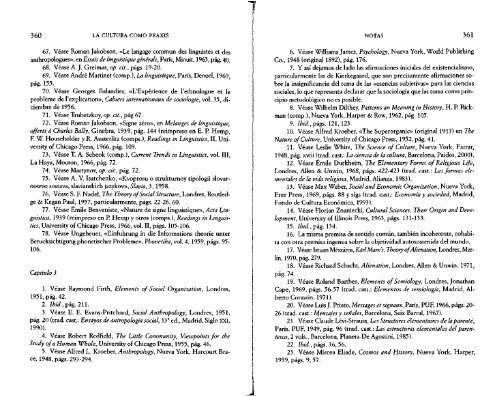Zygmunt Bauman La cultura como praxis
Zygmunt Bauman La cultura como praxis
Zygmunt Bauman La cultura como praxis
You also want an ePaper? Increase the reach of your titles
YUMPU automatically turns print PDFs into web optimized ePapers that Google loves.
360 LA CULTURA COMO PRAXIS<br />
67. Véase Román Jakobson, «Le langage commun des linguistes et des<br />
anthropologues», en Essais de linguistique genérale, París, Minuit, 1963, pág. 40.<br />
68. Véase A. J. Greimas, op. cit., págs. 19-20.<br />
69. Véase André Martinet (comp.), <strong>La</strong> linguistique, París, Denoel, 1969,<br />
pág. 155.<br />
70. Véase Georges Balandier, «L'Expérience de l'ethnologue et le<br />
probléme de l'explication», Cahiers internationaux de sodologie, vol. 35, diciembre<br />
de 1956.<br />
71. Véase Trubetzkoy, op. cit., pág 67.<br />
72. Véase Román Jakobson, «Signe zéro», en Melanges de linguistique,<br />
offerts a Charles Bally, Ginebra, 1939, pág. 144 (reimpreso en E. P. Hemp,<br />
F. W. Householder y R. Austerlitz (comps.), Readings in Linguistics, II, University<br />
of Chicago Press, 1966, pág. 109.<br />
73. Véase T. A. Sebeok (comp.), Current Trenas in Linguistics, vol. III,<br />
<strong>La</strong> Haya, Mouton, 1966, pág. 72.<br />
74. Véase Martynov, op. cit., pág. 72.<br />
75. Véase A. V. Isatchenko, «Kvoprosu o strukturnoy tipologii slovarnowvo<br />
sostava, slavianskich jazykov», Slavia, 3,1958.<br />
76. Véase S. F. Nadel, The Tkeory of SocialSfracture, Londres, Routledge<br />
&L Kegan Paul, 1957, particularmente, págs. 22-26, 60.<br />
77. Véase Emile Benveniste, «Nature de signe linguistique», Acta Lingüistica,<br />
1939 (reimpreso en P. Hemp y otros (comps.), Readings in Linguistics,<br />
University of Chicago Press, 1966, vol. II, págs. 105-106.<br />
78. Véase Ungeheuer, «Einfuhrung in die Informations theorie unter<br />
Berucksichtigung phonetischer Probléme», Phonetika, vol. 4,1959, págs. 95-<br />
106.<br />
Capítulo 3<br />
1. Véase Raymond Firth, Elements of Social Organization, Londres,<br />
1951, pág. 42.<br />
2. Ib¿d.,pág. 211.<br />
3. Véase E. E. Evans-Pritchard, Social Anthropology, Londres, 1951,<br />
pág. 20 (trad. cast.: Ensayos de antropología social, 13 a ed., Madrid, Siglo XXI,<br />
1990).<br />
4. Véase Robert Redfield, The Little Community, Viewpoints for the<br />
Study of a Human Whole, University of Chicago Press, 1955, pág. 46.<br />
5. Véase Alfred L. Kroeber, Anthropology, Nueva York, Harcourt Brace,<br />
1948, págs. 293-294.<br />
NOTAS 361<br />
6. Véase Williams James, Psychology, Nueva York, World Publishing<br />
Co., 1948 (original 1892), pág. 176.<br />
7. Y así dejamos de lado las afirmaciones iniciales del existencialismo,<br />
particularmente las de Kierkegaard, que son precisamente afirmaciones sobre<br />
la insignificancia del tema de las «esencias subjetivas» para las ciencias<br />
sociales, lo que representa declarar que la sociología que las toma <strong>como</strong> principio<br />
metodológico no es posible.<br />
8. Véase Wilhelm Düthey, Patterns an Meaning in History, H. P. Rickman<br />
(comp.), Nueva York, Harper & Row, 1962, pág. 105.<br />
9. ító/.,págs. 121,123.<br />
10. Véase Alfred Kroeber, «The Superorganic» (original 1917) en The<br />
Nature of Culture, University of Chicago Press, 1952, pág. 41.<br />
11. Véase Leslie White, The Science of Culture, Nueva York, Parrar,<br />
1948, pág. xviii (trad. cast.: <strong>La</strong> ciencia de la <strong>cultura</strong>, Barcelona, Paidós, 2000).<br />
12. Véase Émile Durkheim, The Elementary Forms of Religious Life,<br />
Londres, Alien & Unwin, 1968, págs. 422-423 (trad. cast.: <strong>La</strong>s formas elementales<br />
de la vida religiosa, Madrid, Alianza, 1983).<br />
13. Véase Max Weber, Social and Economic Organization, Nueva York,<br />
Free Press, 1969, págs. 88 y sigs (trad. cast.: Economía y sociedad, Madrid,<br />
Fondo de Cultura Económica, 1993).<br />
14. Véase Florian Znaniecki, Cultural Sciences, Their Origin andDevelopment,<br />
University of Illinois Press, 1963, págs. 131-133.<br />
15. /te¿,pág. 134.<br />
16. <strong>La</strong> misma premisa de sentido común, también incoherente, cohabita<br />
con otra premisa ingenua sobre la objetividad autosostenida del mundo.<br />
17. Véase Istuan Mészáros, KarlMarx's, Theory ofAlienation, Londres, Merlin,<br />
1970, pág. 279.<br />
18. Véase Richard Schacht, Alienation, Londres, Alien & Unwin, 1971,<br />
pág. 74.<br />
19. Véase Roland Barthes, Elements of Semiology, Londres, Jonathan<br />
Cape, 1969, págs. 56-57 (trad. cast.: Elementos de semiología, Madrid, Alberto<br />
Corazón, 1971).<br />
20. Véase Luis J. Prieto, Messages et signaux, París, PUF, 1966, págs. 20-<br />
26 (trad. cast.: Mensajes y señales, Barcelona, Seix Barral, 1967).<br />
21. Véase Claude Lévi-Strauss, Les Structures élémentaires de la párente,<br />
París, PUF, 1949, pág. 96 (trad. cast.: <strong>La</strong>s estructuras elementales del parentesco,<br />
2 vols., Barcelona, Planeta-De Agostini, 1985).<br />
22. Ibid., págs. 36,56.<br />
23. Véase Mircea Eliade, Cosmos and History, Nueva York, Harper,<br />
1959, págs. 9,57.


